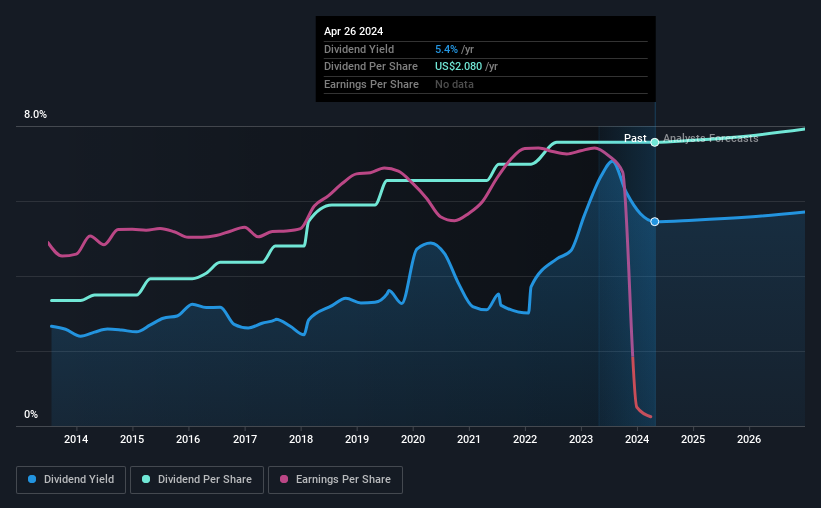Truist Financial (NYSE:TFC) Will Pay A Dividend Of $0.52
Truist Financial Corporation (NYSE:TFC) will pay a dividend of $0.52 on the 3rd of June. Based on this payment, the dividend yield on the company's stock will be 5.4%, which is an attractive boost to shareholder returns.
View our latest analysis for Truist Financial
Truist Financial's Earnings Will Easily Cover The Distributions
If the payments aren't sustainable, a high yield for a few years won't matter that much.
Truist Financial has established itself as a dividend paying company with over 10 years history of distributing earnings to shareholders. Despite this history however, the company's latest earnings report actually shows that it didn't have enough earnings to cover its dividends. This is an alarming sign for the sustainability of its dividends, as it may mean that Truist Financialis pulling cash from elsewhere to keep its shareholders happy.
According to analysts, EPS should be several times higher in the next 3 years. In addtion, they also estimate the future payout ratio could reach 53% in the same time period, which we would be comfortable to see continuing.
Truist Financial Has A Solid Track Record
Even over a long history of paying dividends, the company's distributions have been remarkably stable. The annual payment during the last 10 years was $0.92 in 2014, and the most recent fiscal year payment was $2.08. This implies that the company grew its distributions at a yearly rate of about 8.5% over that duration. The growth of the dividend has been pretty reliable, so we think this can offer investors some nice additional income in their portfolio.
Dividend Growth May Be Hard To Come By
The company's investors will be pleased to have been receiving dividend income for some time. However, things aren't all that rosy. Truist Financial has seen earnings per share falling at 9.7% per year over the last five years. Declining earnings will inevitably lead to the company paying a lower dividend in line with lower profits. Earnings are predicted to grow over the next year, but we would remain cautious until a track record of earnings growth is established.
Truist Financial's Dividend Doesn't Look Sustainable
In summary, while it's good to see that the dividend hasn't been cut, we are a bit cautious about Truist Financial's payments, as there could be some issues with sustaining them into the future. We can't deny that the payments have been very stable, but we are a little bit worried about the very high payout ratio. We would probably look elsewhere for an income investment.
It's important to note that companies having a consistent dividend policy will generate greater investor confidence than those having an erratic one. However, there are other things to consider for investors when analysing stock performance. As an example, we've identified 1 warning sign for Truist Financial that you should be aware of before investing. Is Truist Financial not quite the opportunity you were looking for? Why not check out our selection of top dividend stocks.
Have feedback on this article? Concerned about the content? Get in touch with us directly. Alternatively, email editorial-team (at) simplywallst.com.
This article by Simply Wall St is general in nature. We provide commentary based on historical data and analyst forecasts only using an unbiased methodology and our articles are not intended to be financial advice. It does not constitute a recommendation to buy or sell any stock, and does not take account of your objectives, or your financial situation. We aim to bring you long-term focused analysis driven by fundamental data. Note that our analysis may not factor in the latest price-sensitive company announcements or qualitative material. Simply Wall St has no position in any stocks mentioned.

 Yahoo Finance
Yahoo Finance 
